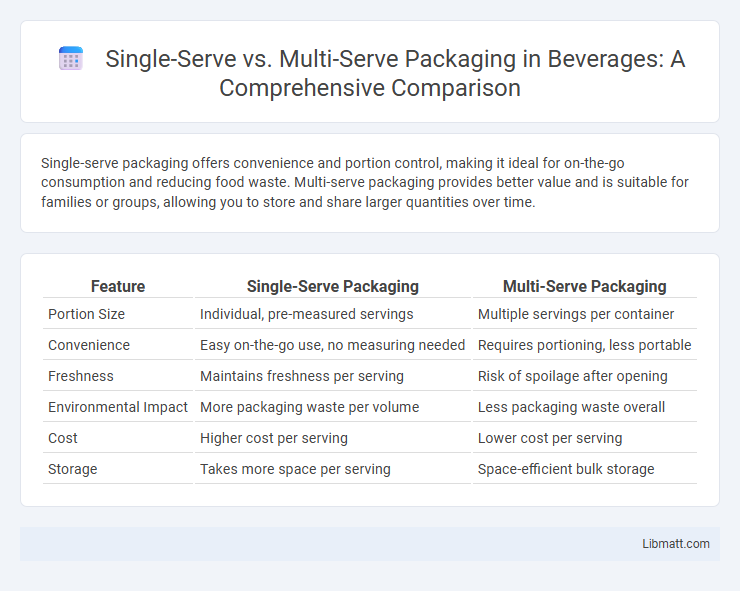Single-serve packaging offers convenience and portion control, making it ideal for on-the-go consumption and reducing food waste. Multi-serve packaging provides better value and is suitable for families or groups, allowing you to store and share larger quantities over time.
Table of Comparison
| Feature | Single-Serve Packaging | Multi-Serve Packaging |
|---|---|---|
| Portion Size | Individual, pre-measured servings | Multiple servings per container |
| Convenience | Easy on-the-go use, no measuring needed | Requires portioning, less portable |
| Freshness | Maintains freshness per serving | Risk of spoilage after opening |
| Environmental Impact | More packaging waste per volume | Less packaging waste overall |
| Cost | Higher cost per serving | Lower cost per serving |
| Storage | Takes more space per serving | Space-efficient bulk storage |
Understanding Single-Serve and Multi-Serve Packaging
Single-serve packaging provides individual portions designed for convenience, freshness, and portion control, ideal for on-the-go consumption. Multi-serve packaging contains multiple servings within a single container, optimizing product volume and reducing overall packaging waste. Choosing the right option depends on Your lifestyle preferences, storage capacity, and environmental considerations.
Key Differences Between Single-Serve and Multi-Serve Packaging
Single-serve packaging offers portion-controlled convenience, ideal for on-the-go consumption and minimizing waste, whereas multi-serve packaging is designed for larger quantities, catering to group use or multiple servings over time. Single-serve packages typically enhance freshness and ease of use, while multi-serve packaging emphasizes cost efficiency and environmental impact by reducing excess packaging material. Understanding these key differences helps you choose the best packaging based on your consumption patterns and storage needs.
Consumer Convenience: Single-Serve vs Multi-Serve
Single-serve packaging offers unparalleled consumer convenience by providing portion-controlled servings that reduce waste and simplify on-the-go consumption. Multi-serve packaging, while less portable, allows you to store larger quantities and is ideal for families or frequent use, enhancing value and reducing the need for frequent purchases. Choosing between single-serve and multi-serve options depends on your lifestyle preferences and consumption habits.
Environmental Impact of Packaging Choices
Single-serve packaging generates more waste per unit of product compared to multi-serve packaging, leading to increased landfill contributions and resource consumption. Multi-serve packaging often uses less material overall and can reduce carbon emissions through fewer manufacturing and transportation cycles. You can minimize your environmental footprint by choosing multi-serve options that promote packaging efficiency and reduce single-use plastic waste.
Cost Comparison: Single-Serve vs Multi-Serve
Single-serve packaging generally incurs higher per-unit costs due to increased materials, packaging, and manufacturing complexity, whereas multi-serve packaging benefits from economies of scale that reduce cost per serving. Consumer convenience and portion control in single-serve options often justify the premium despite elevated prices. Businesses must evaluate volume discounts and waste reduction when comparing overall cost efficiency between single-serve and multi-serve packaging models.
Shelf Life and Product Freshness
Single-serve packaging offers enhanced product freshness by minimizing exposure to air and contaminants, extending shelf life once opened. Multi-serve packaging, while cost-effective, may reduce freshness quickly after the first use due to repeated exposure to oxygen and moisture. Choosing single-serve options ensures Your product remains fresh and safe for consumption longer, especially for perishable items.
Packaging Materials: Trends and Innovations
Single-serve packaging increasingly incorporates sustainable materials such as biodegradable plastics and compostable films, driven by consumer demand for eco-friendly options. Multi-serve packaging innovations focus on resealable features and recyclable components, optimizing convenience while reducing environmental impact. Advances in smart packaging, including moisture and freshness indicators, are emerging across both single-serve and multi-serve formats, enhancing product quality and shelf life.
Health and Portion Control Considerations
Single-serve packaging offers precise portion control, helping you manage calorie intake and reduce overeating, which is beneficial for maintaining a balanced diet and supporting weight management. Multi-serve packaging may lead to unintentional overconsumption due to larger quantities, making it harder to track portions and nutritional content. Choosing single-serve options can enhance health outcomes by promoting mindful eating and preventing excess calorie consumption.
Market Trends and Consumer Preferences
Single-serve packaging continues to gain traction in urban markets due to increasing demand for convenience and portion control, particularly among busy professionals and health-conscious consumers. Multi-serve packaging remains preferred in family households seeking cost-efficiency and reduced waste, with innovations focusing on resealable and recyclable materials. Market trends indicate a growing preference for sustainable single-serve options as eco-awareness rises, driving manufacturers to balance convenience with environmental impact.
Choosing the Right Packaging for Your Product
Choosing the right packaging for your product depends on factors such as target audience, product type, and usage frequency. Single-serve packaging offers convenience, portion control, and freshness, ideal for on-the-go consumers and trial products. Multi-serve packaging reduces waste and cost per use, making it suitable for family-sized products and long-term storage.
Single-serve vs multi-serve packaging Infographic

 libmatt.com
libmatt.com